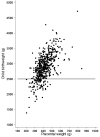Mother's lifetime nutrition and the size, shape and efficiency of the placenta
- PMID: 21924491
- PMCID: PMC3223394
- DOI: 10.1016/j.placenta.2011.09.001
Mother's lifetime nutrition and the size, shape and efficiency of the placenta
Abstract
Background: Studies have shown that the shape and size of the placenta at birth predict blood pressure in later life. The influences that determine placental morphology are largely unknown. We have examined the role of mother's body size.
Methods: We studied 522 neonates who were born in a maternity hospital in Mysore, South India. The weight of the placenta and the length and breadth of its surface, were measured after delivery.
Results: Higher maternal fat mass predicted a larger placental surface (p = 0.02), while larger maternal head circumference predicted a more oval placental surface (p = 0.03). Higher maternal fat mass and larger maternal head circumference were associated with greater placental efficiency, indicated by lower ratios of the length (p = 0.0003 and p = 0.0001 respectively) and breadth (p = 0.0002 and p < 0.0001) of the surface to birthweight. In a sub-sample of 51 mothers whose own birthweight was available, higher maternal birthweight was related to lower ratios of the length and breadth of the surface to birthweight (p = 0.01 and 0.002). Maternal height was unrelated to placental size or shape.
Conclusions: Higher maternal fat mass, reflecting the mother's current nutritional state, and larger maternal head circumference, reflecting the mother's fetal/infant growth, are associated with changes in the shape and size of the placental surface and greater placental efficiency. We suggest that these associations reflect effects of the mother's nutrition at different stages of her lifecourse on the development of the placenta and on materno-placento-fetal transfer of nutrients.
Copyright © 2011 Elsevier Ltd. All rights reserved.
References
-
- Hill JC, Krishnaveni GV, Annamma I, Leary SD, Fall CHD. Glucose tolerance in pregnancy in South India: relationships to neonatal anthropometry. Act Obstet Gynecol Scand. 2005;84:159–65. - PubMed
Publication types
MeSH terms
Grants and funding
LinkOut - more resources
Full Text Sources
Medical


